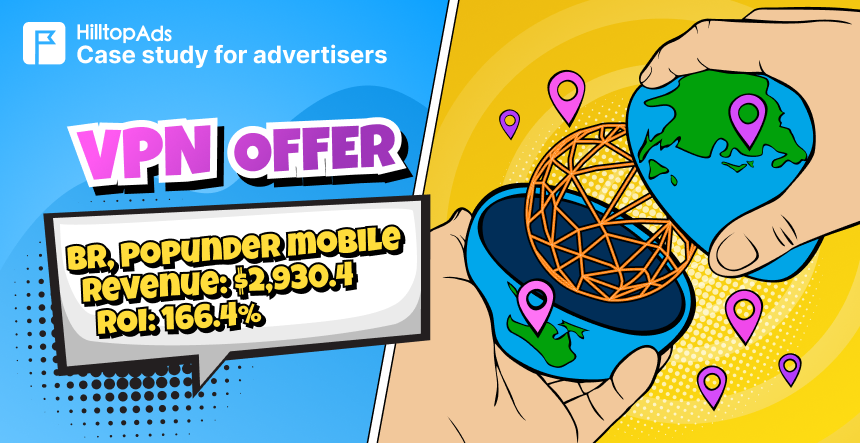Campaign growth in affiliate marketing often stalls at the start, but we’ve discovered a formula that truly works. A VPN campaign in Brazil using mobile popunder ads generated $2,930.4 in just 10 days with a 166.4% ROI. The article reveals how to select the right GEO, optimize targeting for mobile users, and leverage ad formats that drive maximum conversion.
Key Points
Offer: VPN
GEO: BR (Brazil)
Traffic: Non-Mainstream High and Medium Activity; Mainstream High and Medium Activity
Ad Format: Popunder mobile
Ad campaign period: 20 November – 30 November
Revenue: $2,930.4
ROI: 166.4%

Launch your first advertising campaign with HilltopAds
and next time we’ll tell you about your success.
VPN Market Growth and Traffic Arbitrage Prospects in 2025
You’re probably already well-versed in VPN offers and don’t need much explanation about what they are. However, we’ve put together a quick overview and assessed the prospects of the VPN market for 2025.
A VPN, or a Virtual Private Network, is an Internet technology that allows users to connect to the Internet securely over an open network as if they are connecting to a private one.
When it comes to VPN offers, these are advertising propositions related to VPN services, promoted through various ad formats (e.g., popunder, banners, native ads). The goal of these campaigns is to attract subscribers or paying users to VPN services, maximizing monetization based on the traffic generated. Typically, VPN offers operate on a CPA (cost-per-action) model, where advertisers earn for each VPN service download or subscription.
VPN Market Volume and Vertical Prospects in 2025:
Rising Interest
Over the past few years, VPN services have grown tremendously in popularity. This is fueled by the growing online security risks, the spread of cyberattacks, the users’ need for anonymity, and the potential to circumvent geographical limitations (e.g., access to streaming websites or social media).
Prospects for 2025
The VPN industry is expected to continue growing, driven by an increase in mobile users and increased focus on data protection. By 2025, the global VPN market is estimated to reach $37 billion, growing by about 15-20% every year. This is an excellent opportunity for traffic arbitrage experts as more users are searching for ways to protect their online traffic.
Competition and Opportunities
By 2025, the VPN vertical will remain competitive, but thanks to rising demand and expanding markets (such as in developing countries and Asian regions), traffic arbitrage specialists will find new opportunities. The key will be being able to discover and capitalize on less saturated geographic regions, such as South America, Eastern Europe, or Asia.
Research forecasts that by 2027, the VPN market will be valued at 92 billion dollars.
Choosing the Best GEO: Best Regions to Provide VPN
In selecting VPN offers, the right GEO can be crucial to the success of an ad campaign. Following are three significant regions, North America, Asia, and Latin America, and a review of their potential for promoting VPN offers:
North America: A High-Stakes Market
The USA, Mexico, and Canada are considered to be the most favorable GEOs to launch VPN offers. They have high usage, and as a result, are extremely sought-after to arbitrage traffic. Demand is high, but so is competition, so it is important to enter these markets with a strong offer to be successful.
Asia: A Region with Growing Potential
Asian countries including Indonesia, Japan, the Philippines, Hong Kong, and South Korea are low-competition but high-demand markets. There is an excellent chance to introduce successful VPN ad campaigns here, as the market is promising and full of potential.
Europe and Latin America: Markets with Unique Dynamics
The UK and Venezuela stand out especially as they have strong local internet regulations, and CIS countries have a strong desire to use VPNs due to content blocking and censorship. These unique conditions present opportunities to tackle specific user needs and tailor campaigns accordingly.
We chose Brazil, an out-of-the-ordinary GEO for VPN promotions. People are eager to find ways to secure their data and evade online threats, and there is an excellent arbitrage traffic potential there. In these GEOs, it’s important to emphasize the importance of protecting personal data and work out ad campaigns to address the users’ burning concerns regarding security.
While it’s known that Brazilians speak a variant of English, many aren’t aware that the local population has limited proficiency in the language. Therefore, everything—from creatives to landing pages and apps—needs to be translated into Brazilian Portuguese to ensure the message is clear and accessible.
Today, 77% of the Brazilian population is covered by the internet, and mobile is the most prevalent means to access the internet. There are more mobile devices used to access the internet than the total population. Mobile internet speeds have an average speed of 22 Mbps. Statistically, on average, Brazilians spend 5 hours a day online, driven by the heavy usage of streaming media such as video, music, and podcasts. 78% of smartphones are also utilized to play video games. This translates to mobile traffic and in-app ad spend in gaming applications being top priorities.
Given the high mobile traffic and growing interest in online security, developing markets like Brazil are becoming increasingly attractive for traffic arbitrage professionals. The key to success lies in the proper adaptation of content and strategy, which we will dive into in the following section.
Advertising Campaign Launch Strategies
For a successful advertising campaign, a strategic approach is essential—relying on luck alone is not enough. Let’s break down how to effectively launch an advertising campaign in Brazil, based on GEO analysis insights.
The first key factor is the visuals. Brazilians are highly patriotic and take pride in their country, so creatives that incorporate national colors, symbols, and emblems are likely to resonate well. The second important thing is to align your creatives with national holidays, such as Carnival (Feb 25 to Mar 5), Catholic Easter, Rock in Rio music festival (Sept 2 to 11), and Brazil’s local Halloween (Nov 1-2). Targeted, personalized messaging based on location, interest, or cultural attributes will also garner trust and create engagement.
When it comes to grabbing attention in Brazil, think like a local: people here love freebies, discounts, and special deals. Throw those perks into your ads, and watch your conversion rates skyrocket.
Take our VPN offer, for instance. When someone clicks that “Get It Now” button, they land straight in the App Store—zero cost, zero fuss. People love how quick and easy it is, and that’s why installs (and conversions) go through the roof. No complicated steps, just tap, download, done.
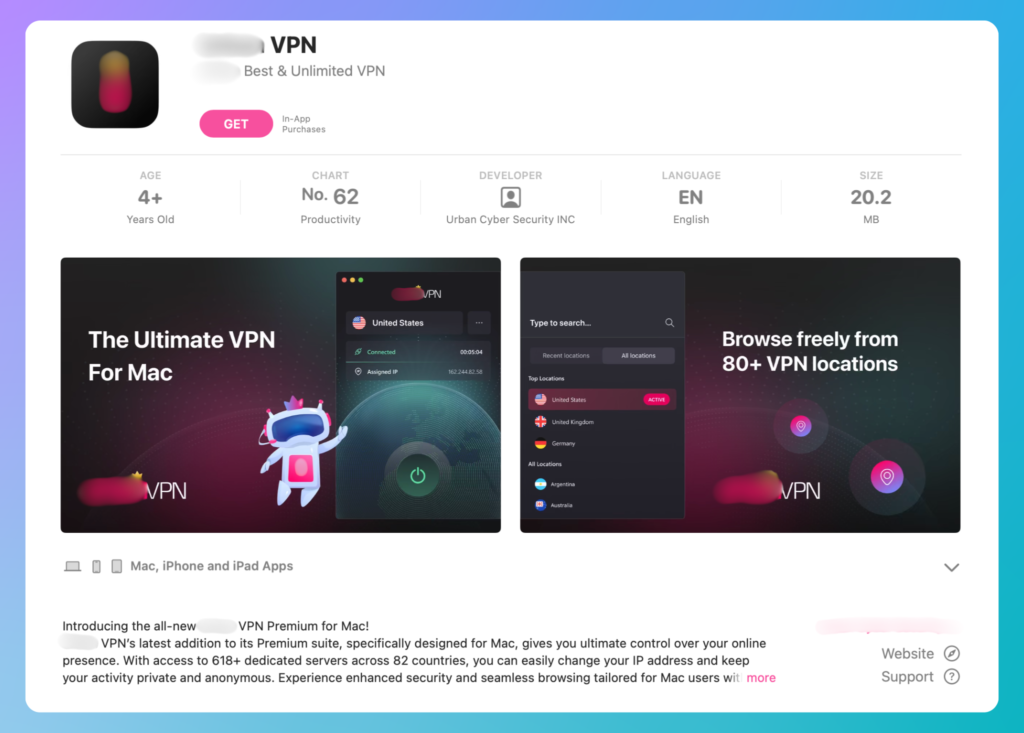
One other advantage is the low competition in the Brazilian online market. This is good news to both veteran traffic arbitrage masters and newcomers, as there are ample opportunities to be successful without much competition.
Let’s move on to the Popunder Mobile ad format. One of the strongest mobile traffic formats, it opens the ad in a new window behind the content. It is particularly effective in high mobile usage countries, including Brazil, where users continuously interact with mobile content. Popunder ads are an unobtrusive yet strong way to get attention without interfering with the user experience, ensuring the ad is noticed without impacting the main content.
Considering all these factors, Brazil stands out as an excellent GEO for promoting VPN offers and beyond, especially when leveraging the Popunder ad format. With the right content adaptation, eye-catching creatives, and a strategic targeting approach, you can ensure your advertising campaign’s success.
General settings for an advertising campaign on the HilltopAds platform
Before launching an advertising campaign on HilltopAds ad network, you need to register as an advertiser. You can register using this link.
To create an advertising campaign, follow these steps:
- In the Traffic Channels section, choose Non-Mainstream High and Medium Activity; Mainstream High and Medium Activity
- Go to the Manage Campaigns section
- Click the Add Campaign button
- In the campaign creation section, select the Popunder mobile ad format
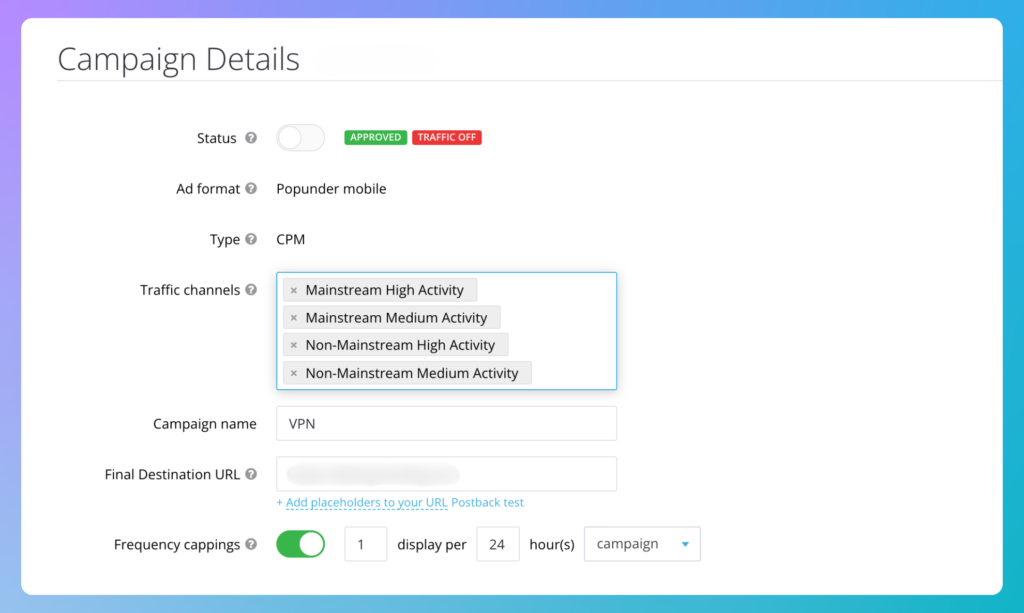
Next, it’s essential to set up the Postback to track the results of your ad campaign. For a detailed description of working with Postback and the available placeholders, check out our guide.
In simple terms, for the final URL of your offer, you’ll need to insert parameters to pass conversions and source IDs. The parameter for conversions is
click_id, and the source ID iszone_id.
The resulting Final Destination URL should look like this:
https://my_offer.net/?&click_id={{ctoken}}&s1={{zoneid}}
- {{ctoken}} – HilltopAds parameter for passing conversions.
- {{zoneid}} – HilltopAds parameter for passing source ID.
You can also add any other parameters available for further campaign analysis, but remember to include the click_id parameter in the final link to track conversions.

Start working with HilltopAds
to put the knowledge from the case into practice
Next, set up the necessary targeting settings:
- GEO – BR (Brazil)
- OS – iOS
- OS Version – 14, 15, 16, 17, 18
- Device – mobile and tablet
- Language – Portuguese
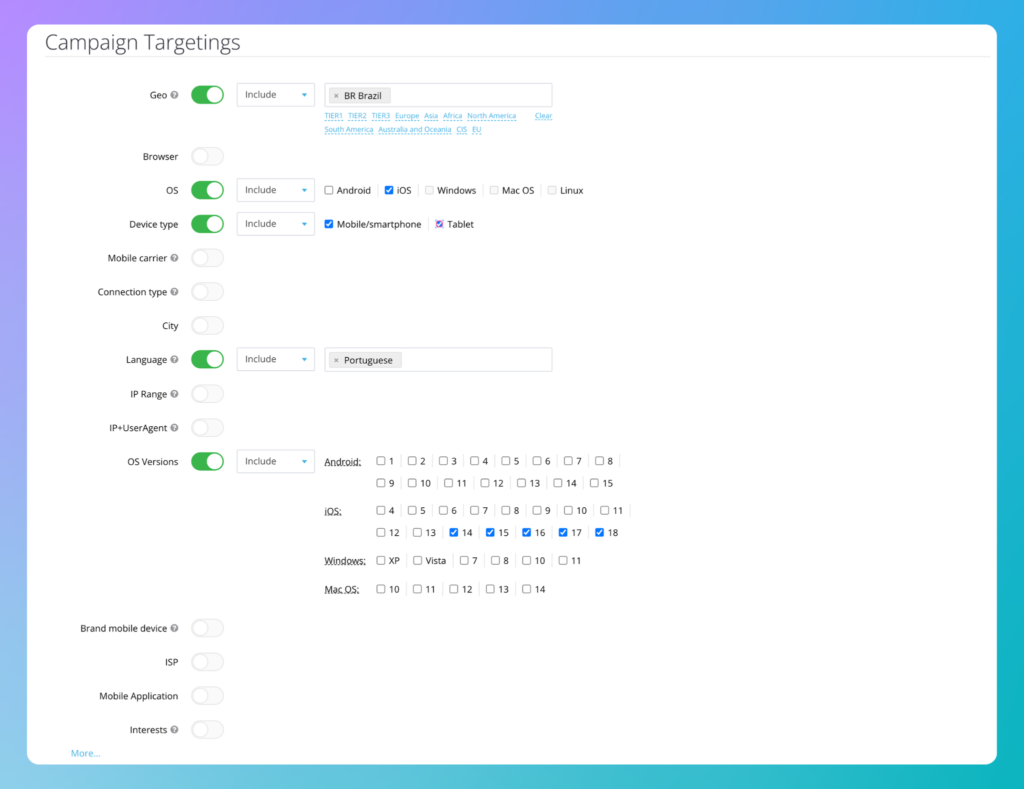
You can also configure campaign filters and allow/disallow Proxy and WebView traffic from the campaign. In this case, we enabled the WebView filter while disabling Proxy traffic:
- Proxy – disallow
- WebView – allow

You can set both daily and total budget limits, but keep in mind the daily limit shouldn’t fall below $20. During testing, we used a daily budget of $100 for the campaign.
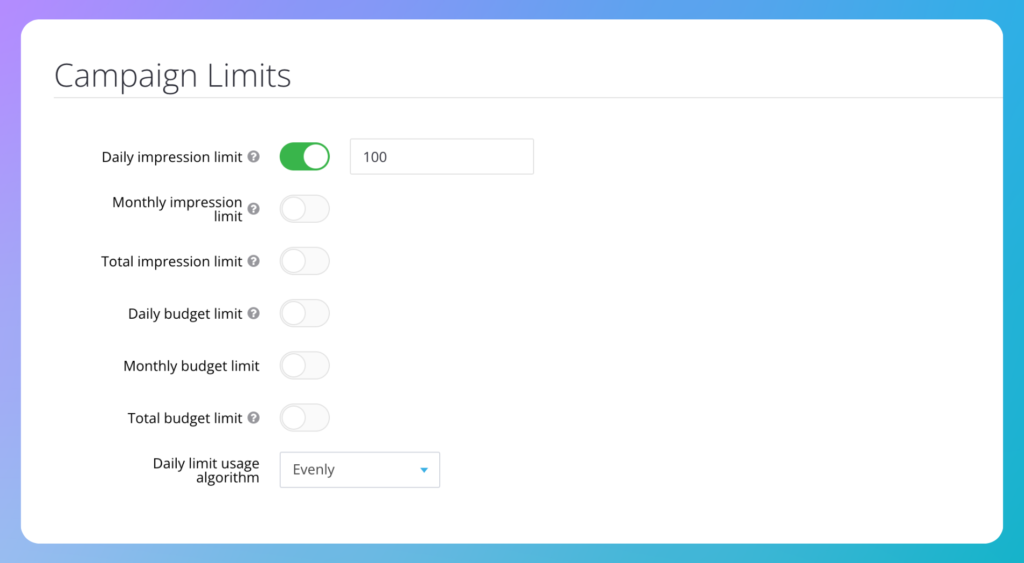
The final step before launching your VPN campaigns is to set the cost per thousand impressions (CPM). Pay attention to the Traffic Volumes graph in the top-left corner, which shows premium, minimum, and recommended CPM rates.
We set a CPM bid of $1.0 to ensure accurate and consistent performance data, helping us measure the effectiveness of our single campaign.
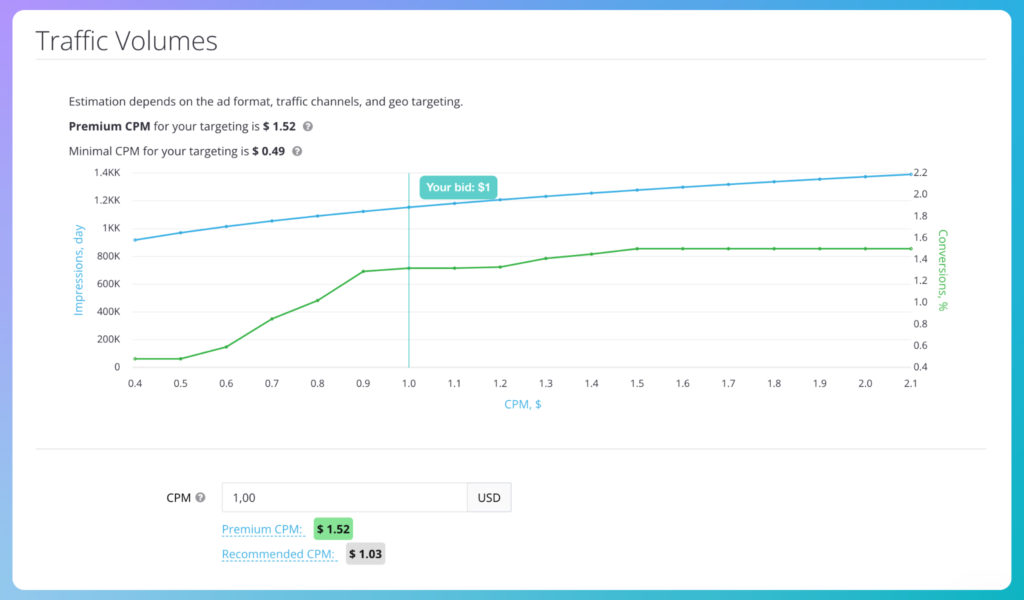
Advice from HilltopAds:
As a starting point to test a new offer, use the suggested CPM. This will indicate if the offer is performing and if the campaign should be optimized.
Optimization and Tracker
We utilized the automatic optimization tool from the beginning of the campaign, and we set the parameters of analysis to 24 hours, with a minimum 1,500 impression and less than 1 conversion. This served to cut costs on under-performing ad sources and allocate budget to more promising segments. Additionally, to properly monitor the conversions, we installed a postback tracker through Voluume to ensure accurate data transfer for optimization.
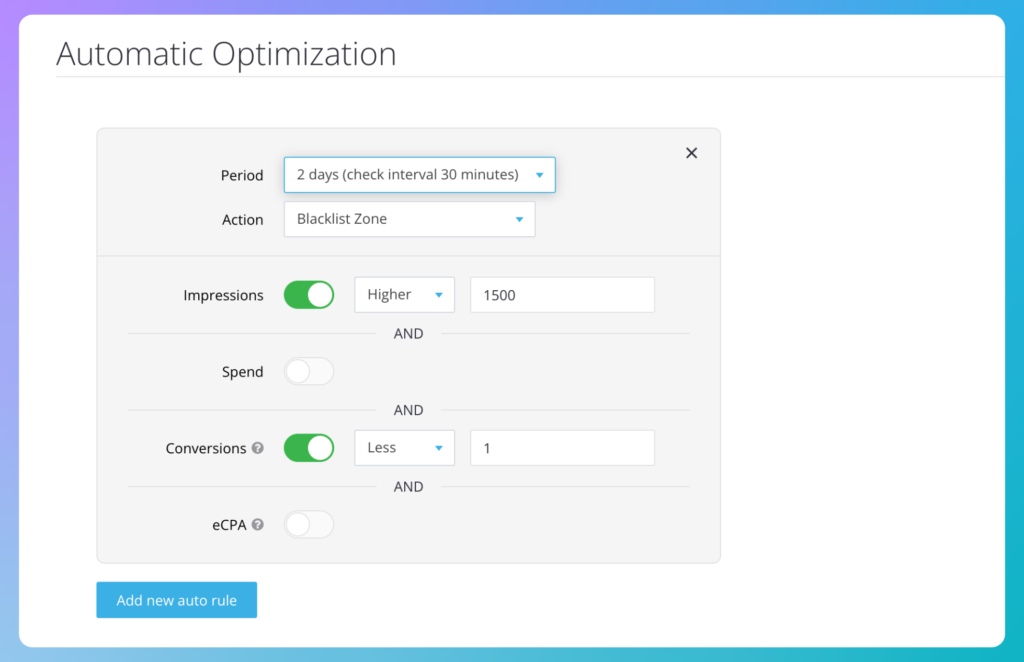
The 11-day ad campaign metrics can be seen from the screenshot taken from the Voluum tracker. This provides a clear indication of how the campaign fared, including metrics and the obtained conversions during the test duration.
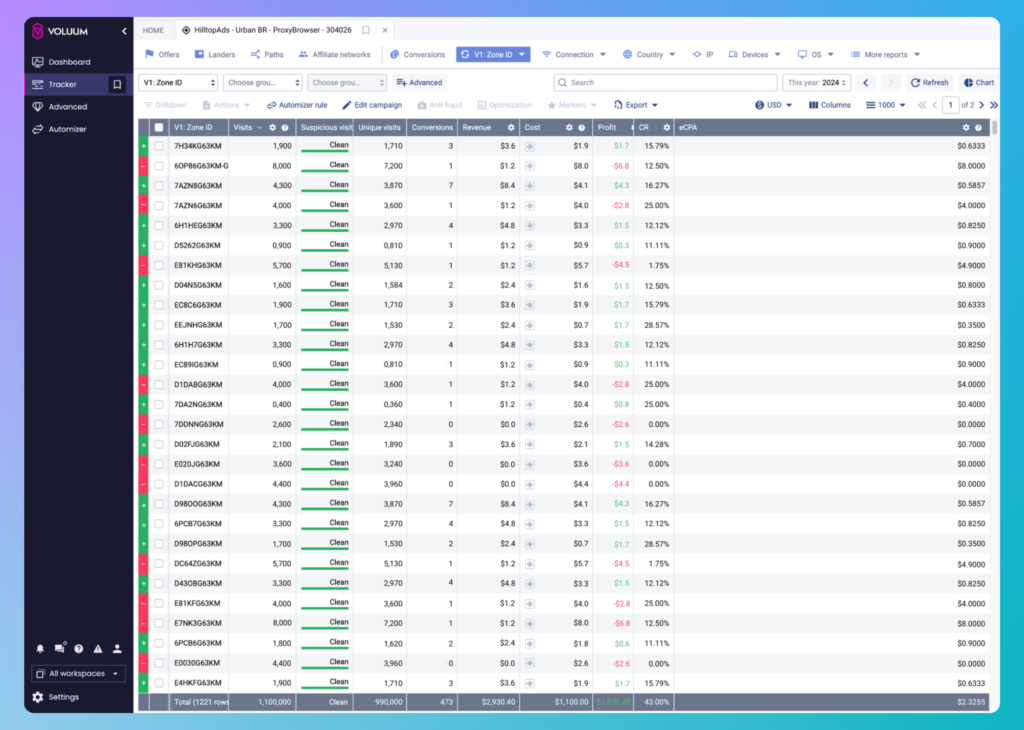
Auto Optimization is a tool for automatically adding non-performing traffic sources. Thanks to this feature, the HilltopAds system removes non-profit sources from your advertising campaign and adds them to the BlackList.
For more information regarding the abilities of automatic optimization by HilltopAds, visit the website to read the article:
Results
After carefully tuning the advertising campaign for 11 days, we achieved the following results:
- Total Costs (Spent) – $1,100
- Total Earnings (Profit) – $2,930.4
- ROI (Return on Investment) – 166.4%
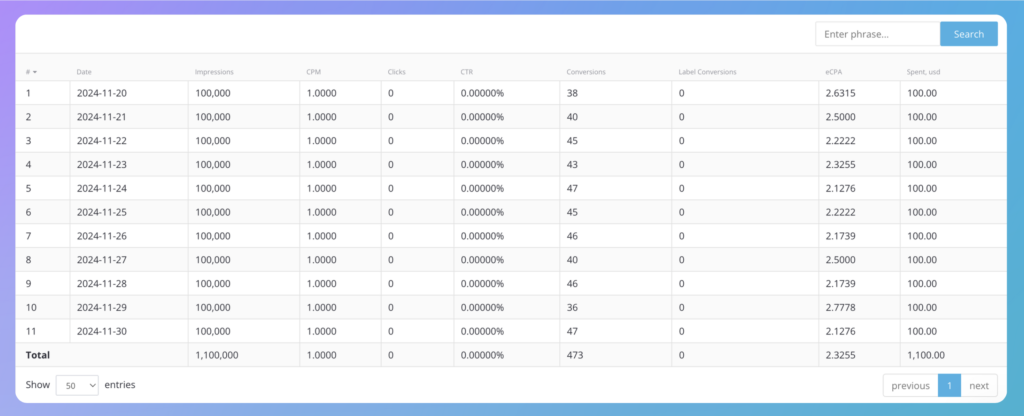
To calculate ROI, check out our other practical case study:
Here, the return on investment is 166.4%.
Key Takeaways and Recommendations
This VPN campaign in Brazil demonstrated that thinking outside the box can lead to exceptional results. A strong localization strategy, the right ad formats, and ongoing optimization turned a relatively small budget into a major success, delivering a 166.4% ROI.
Lessons Learned
Localization is a Game-Changer
Translating creatives and landing pages into Brazilian Portuguese and integrating cultural elements (like national symbols) fostered trust and boosted engagement. Brazilians appreciate when brands speak their language—literally and figuratively.
Popunder Ads Are Best for Mobile Traffic
Brazil’s mobile culture resulted in the popunder ad format being the best choice. It got attention without being intrusive, offering great exposure.
Optimize, Optimize, Optimize
Using tools like HilltopAds’ Auto Optimization helped cut out low-performing traffic sources, reallocating the budget to where it truly mattered.
Low Competition, Big Opportunities
Brazil’s relatively untapped market offers plenty of room for both seasoned pros and beginners in traffic arbitrage.
Recommendations for Future Campaigns
Test Beyond the Usual GEOs
Brazil is a fantastic market, but don’t stop there. Explore regions like Southeast Asia (Indonesia, Philippines) or other parts of Latin America (Venezuela, Argentina) with growing demand and less saturation.
Leverage Local Culture
Tailor your creatives to local holidays, traditions, and preferences. For Brazil, think Carnival vibes, football themes, and a splash of national pride. Personalization = conversions.
Prioritize Mobile
Make sure your offers and landing pages are mobile-optimized. In emerging markets, mobile traffic rules the game, and slow-loading pages are deal-breakers.
Use Data to Your Advantage
Implement advanced tracking tools like Voluum to monitor conversions. Data-driven decisions will save you money and help scale winning campaigns faster.
Start with Smart Budgets
Begin with the recommended CPM rates and scale up only after analyzing performance.
Offer Real Value
Brazilians love deals, freebies, and anything that screams “special offer.” Highlight benefits like enhanced privacy, discounted plans, or free trials to encourage action.
Ride the VPN Growth Wave
With the global VPN market projected to hit $37 billion by 2025, staying ahead of trends is crucial. Keep an eye on developing technologies and new consumer needs.
The VPN niche isn’t just growing—it’s thriving. With the right mindset and tools, there’s no limit to how far you can scale. So, what’s your next GEO going to be? Use a promo code VPNCASE and get +20% to your first deposit of at least $100.


















